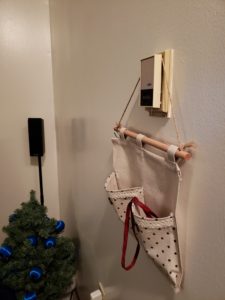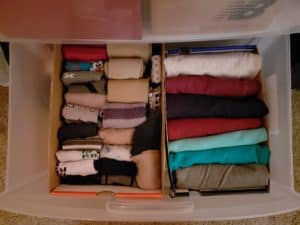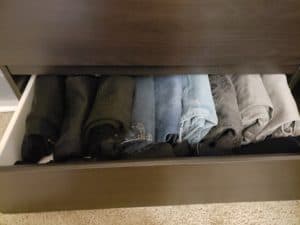I just finished listening to The Life-Changing Magic of Tidying Up: The Japanese Art of Decluttering and Organizing by Marie Kondo audiobook, and I decided to implement what I’ve read.
So, on weekend, I spent my day decluttering my bedroom and workspace.
I’ve realized that I often lost my items such as my phone and car key, and I ended up looking for it frantically in the morning before heading to the office.
This little annoyance happens every day and has actually a real cost. It made me start my day off annoyed.
5 minutes here and there can be a lot when I add them up. As soon as Saturday coming, I decluttered and organized my belongings using Kondo method as a guide.
I’d like to share my experience, and perhaps this might be interesting for you to check out! Definitely, the book has a lot more insights than the summary I provided. But here are the steps that I went through.
Start by Discarding
Firstly, I started by discarding items by category. As recommended by Kondo, I asked myself on each item – “Does this spark me joy?”.
Kondo believes that we should be surrounded by the things that bring us joy. If it does not, thank for its service and discard the item.
To me, this makes sense because I will have more spaces I only have to organize my joy-giving belongings.
Sort by category, not location
Normally, I would clean per room. Instead, Kondo’s first rule is to tidy per category. Items that fall into the same category can be spread all over the house, such as – clothes.
She advises to search through items and gather all of them. After sorting one category, we can move on the to next one. The purpose is to avoid the whole repetition of choosing and storing.
Kondo says the best sequence is to start with clothes, then books, papers, miscellaneous items, and finally stuff that holds sentimental value. So, I started with these sequences.
Kondo does not recommend starting with nostalgia items because this is the hardest category to decide. In addition, starting with this will make you reminisce about old times, thus prevent you from making significant progress.
I personally do not have too many nostalgia items because most of my belongings are in my home country, so fewer things to worry about!
Tyding in one shot as quickly as possible
As suggested by Kondo, I tried to tyde in one shot. I picked a day when I don’t have too many things to do, and I spent several hours on this. I started in the morning (around ~9am) and finished around 4 pm, so it took me roughly 6-7 hours.
I was tempted to sell my stuff on eBay, but it then it will take a while to finish this project. So, I just sent them to Goodwill and sell my book at Half Price book store.
Kondo mentions that tyding in one shot, rather than little by little can dramatically change your mindset. This makes sense because the faster you do the work, the faster you will see improvement, and this will make you more motivated.
Designate a spot for everything
All of the helpful advice in the book, this has the most impact in regards to my disorganization problem. This prevents me to put any objects in a random place when I am in autopilot mode.
As advised by Kondo, I also put them in a visible location so I can access them easily.
Though I have to admit, I have not designated all my belongings – but I started applying this rule to items that I frequently use or lose.

A few things that I did:
- I hang this pocket organizer on the heater button nearby my apartment main door. Every time I come home, I will leave my car key in there.
- I designated my office badge, phone, and charger in my front bag as well. When I search for this item, I don’t need to spend extra minutes to look in another compartment of my backpack.
Results
After discarding, I ended up with five 30 litter garbage bags full of stuff. Although it made me relief seeing how much space I have now, noticing how much money I’ve thrown on those items made me a little sad.
But that is just a reminder that I need to think more deliberately before spending money.
However, as Marie shared in her book, we can thank them for bringing us joy when we bought them or teaching us what does not suit us.


Even though it has been only several weeks – but I never maintain my clean space in the car and apartment room for this long before.
I still have to tidy and maintain this habit. But the cleans up are fewer and farther in between. More importantly, I started to build a habit to put my items back in their designated place.
I also found that deciding what to wear becomes a little easier. Less stuff means fewer options to decide.
Throughout this process, I also learned more about myself – what stuff I like and dislike.
I am still thankful for those items that I let go for teaching me what kind of style does not suit me.
Being productive is about enabling yourself to perform at your very best, every day, and over the course of weeks, months, and years. I was so glad I took the time to declutter and I learned so much throughout this process!

Vi, a software engineer with a keen interest in personal finance, had planned to retire once she reached her lean FI/RE (Financial Independence/Retire Early) goal. However, after achieving the goal, she took few months of a mini-retirement filled with travel and adventure and decided to continue her career.
For the past five years, Vi has been using Personal Capital (Empower), a free financial tool. Her favorite features include the dashboard for net worth, allocation, and planning, which help track her FI/RE goal and keep those investment fees in check.